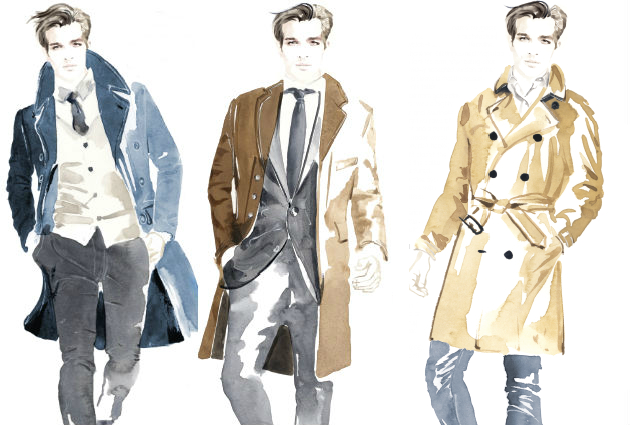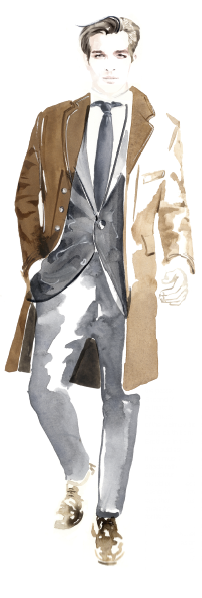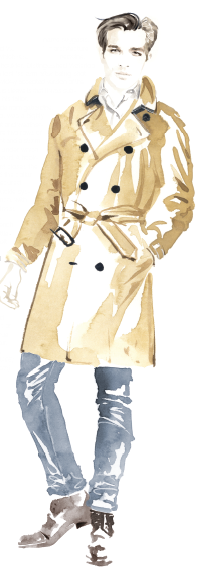Style: three of the best coats for men
Dashing dandy Nick Foulkes singles out the three coats that no self-respecting gentleman should be without


By Nick Foulkes
My overcoats are nothing if not eclectic and, if I have any advice to offer a gentleman in the market for a coat, it is to buy the best and the most you can afford. Over the years, I have assembled a versatile selection that covers most occasions.
For instance, I always feel it’s correct to have the event-appropriate overcoat when undertaking sporting activity. Accordingly, I have a vintage mink cape that I wear over my dinner jacket to backgammon tournaments; I have a belted polo coat, even though I don’t play polo; I have shooting coats in tweed, leather and waxed cotton from Beretta, Purdey and Holland & Holland—such a shame I shoot so terribly; and I have wonderful tweed checked coats, which would have pleased the vibrant-fabric-loving Duke of Windsor, that I wear to Cheltenham for my annual exposure to the joys of National Hunt racing and in which I was once told I looked like a Kelso bookmaker (alas without the takings).
It’s almost cruel to ask me to limit myself to just three, but these are the ones—assuming they are perfectly cut, of course—that are must-haves coats for life.

The Chesterfield
‘Around 1835 there emerged a fashion that provoked wariness among tailors—the overcoat... it took up where the cloak had left off,’ thus recounts Farid Chenoune in his A History of Men’s Fashion.
Count d’Orsay, the renowned mid-19th-century French dandy, is generally credited with inventing the overcoat by buying a shapeless coat from a sailor during a sudden downpour. What the Count wore became, ipsofacto, the height of fashion in the 1830s and 1840s and where the Count led, others, such as the Earl of Chesterfield, followed. It is to this 19th century nobleman that we owe the prototypical and ultimate urban overcoat.
Exquisite houses, the beauty of Nature, and how to get the most from your life, straight to your inbox.
Worn with a dark suit to a funeral, board meeting or anything in between, you can’t go wrong with this coat in either navy or black wool—grey herringbone is also acceptable, but less versatile. Singlebreasted with a fly front to conceal the buttons or double-breasted with wing lapels, it’s an elegant classic that, albeit not as shaped as the frockcoat, brings with it a touch of turn-of-the-century elegance, which was a cornerstone of the Edwardian revival of the 1950s (think Cecil Beaton and Bunny Roger).
If you have the figure for it, this is the coat that you can ask your tailor to give a little shape to through the side seam. I recently came across a very dashing one by Chester Barrie, on a block designed by Edward Sexton, in black with a subtle diamond weave, which was doublebreasted and featured turned-back cuffs and a velvet collar.
Chesterfield coat, £895, Chester Barrie (020–7439 6079; www.chesterbarrie.co.uk)

The covert
The covert, or UKIP coat, as I am sure it will become known to future generations, was as much a part of the Nigel Farage persona during the General Election as the pint glass and cigarette. Although it may not have done much for UKIP at the ballot box, it remains a muchcherished and most British garment. Designed to be worn when riding, apparently the ribbed fawn cloth, similar in construction to keeper’s tweed, stops the horsehair from showing up and the lines of stitching at the hem make the coat robust and resistant to fraying.
I have a covert-style coat that was made for me many years ago in Bedford cord by Terry Haste, which is a little like a suit of armour. Some idea of its durability can be gleaned from the fact that Bedford cord was used to cover the passenger seats of the grander pre-Second World War cars. If you’re not going to have one made, then Cordings has made something of a speciality of these almost indestructible garments using cloth from the legendary Fox Brothers in the West Country.
I would eschew the velvet collar, but, if you must have one, go for a toning shade rather than anything too selfconsciously ‘characterful’. Moreover, the old prejudices about country clothes being worn in town seem to matter less than they used to, so, if you had, quelle horreur, to choose only one coat for life, then this would probably be it.
However, if restricted to one overcoat, I would find winter robbed of one of its chief pleasures and probably emigrate to the Tropics.
Covert coat, £445, Cordings (020–7734 0830; www.cordings.co.uk)

The trench
The trench coat came of age, as its name suggests, during the First World War. Its defining architecture is the raglan sleeve, which reaches to the neckline, covering the entire shoulder. Distinguished Waterloo veteran Lord Raglan lost his arm after being shot by a sniper and the widely accepted version of the birth of the eponymous sleeve is that it was subsequently devised by his tailor.
A true trench is made from gabardine, which, a century ago, was a highly technical, strong, light and weatherproof fabric. There are two rows of buttons down the front and a storm flap at the shoulder, under which the lapel can be buttoned. A hookand-eye arrangement closes the coat at the neck and the collar can be raised and secured using a strap-and-buckle system called a throatlatch, with further weather-tightness assured at the wrist.
A century on, the trench retains many of its battleready features. The belt is equipped with D rings, originally used to suspend equipment, grenades or swords, with shoulder-slung items—such as binoculars and gas masks—secured on the shoulder straps or epaulettes. This is a true and classic multi-tasker.
Trench coat, £1,295,Burberry (0800 279 4998;http://uk.burberry.com)
Country Life is unlike any other magazine: the only glossy weekly on the newsstand and the only magazine that has been guest-edited by His Majesty The King not once, but twice. It is a celebration of modern rural life and all its diverse joys and pleasures — that was first published in Queen Victoria's Diamond Jubilee year. Our eclectic mixture of witty and informative content — from the most up-to-date property news and commentary and a coveted glimpse inside some of the UK's best houses and gardens, to gardening, the arts and interior design, written by experts in their field — still cannot be found in print or online, anywhere else.
